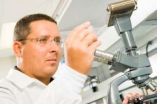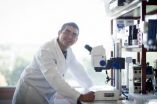(Press-News.org) Who do you look at in a group photo? If you're like most adults, you'll look at yourself first — unless your boss is also in the picture.
A study in PLoS ONE by researchers from the Brain and Creativity Institute at USC and Peking University examines how White Americans and Chinese people in China respond to pictures of their boss, suggesting cultural differences in our responses to authority figures.
Unlike people in China, who responded fastest to pictures of their direct supervisor, White Americans responded faster to pictures of their own face than to pictures of their boss, the study found. However, the American tendency toward individualism is less pronounced if the supervisor is considered someone with high social status.
"What constitutes a social threat may differ across cultures," said Sook-Lei Liew, a doctoral student with the Brain and Creativity Institute at USC and lead author of the study. "Americans may be influenced more by one's social status than one's hierarchical position as a boss."
Past research has shown that people respond faster to their own faces than to the faces of others, suggesting "we have a different — and privileged — system for processing ourselves versus others," Liew explained.
In other words, we are quicker to react to faces we think are important. Most of the time this is our own face, but certain individuals may interfere with how one thinks of oneself, the researchers said.
"The very concept of a "boss" may be different in different cultures," said Lisa Aziz-Zadeh, assistant professor with the Brain and Creativity Institute at USC. "These findings are particularly salient as globalization increases and, along with it, the prevalence of multicultural collaboration, particularly between East Asian and Western partners."
While Americans did not respond faster to photos of their boss than to themselves, they did respond faster to photos of their boss compared to photos of their peers, suggesting that for Americans, the boss figure is influential in the social arena without directly affecting one's self-concept.
The so-called "boss effect" among people in China was first identified in 2009 by Yina Ma and Shihui Han of Peking University, both authors on this study.
###
Liew, et. al, "Who's Afraid of the Boss: Cultural Differences in Social Heirarchies Modulate Self-face Recognition in Chinese and Americans." PLoS ONE: February 16, 2011.
Who's the boss? Americans respond faster to those with high social status
But Chinese respond fastest to their direct supervisor
2011-02-17
ELSE PRESS RELEASES FROM THIS DATE:
GW researchers reveal first autism candidate gene that demonstrates sensitivity to sex hormones
2011-02-17
WASHINGTON— George Washington University researcher, Dr. Valerie Hu, Professor of Biochemistry and Molecular Biology, and her team at the School of Medicine and Health Sciences, have found that male and female sex hormones regulate expression of an important gene in neuronal cell culture through a mechanism that could explain not only higher levels of testosterone observed in some individuals with autism, but also why males have a higher incidence of autism than females.
The gene, RORA, encodes a protein that works as a "master switch" for gene expression, and is critical ...
Mio-Pliocene faunal exchanges and African biogeography: The record of fossil bovids
2011-02-17
New fossil discoveries have provided a glimpse into the biogeographic configuration of Africa over the last seven million years.
Modern-day Africa south of the Sahara is home to a unique variety of mammals, a great number of which are not found anywhere else in the world. Biogeographers have long recognized that sub-Saharan Africa constitutes one of the world's six major mammalian biogeographic divisions, termed 'realms'. However, the historical development of these continental regions of biogeographic diversity has been little explored.
Description of six million-year-old ...
Biological anthropologists question claims for human ancestry
2011-02-17
"Too simple" and "not so fast" suggest biological anthropologists from the George Washington University and New York University about the origins of human ancestry. In the upcoming issue of the journal Nature, the anthropologists question the claims that several prominent fossil discoveries made in the last decade are our human ancestors. Instead, the authors offer a more nuanced explanation of the fossils' place in the Tree of Life. They conclude that instead of being our ancestors the fossils more likely belong to extinct distant cousins.
"Don't get me wrong, these ...
Key culprit identified in breast cancer metastasis
2011-02-17
When doctors discover high concentrations of regulatory T cells in the tumors of breast cancer patients, the prognosis is often grim, though why exactly has long been unclear.
Now new research at the University of California, San Diego School of Medicine suggests these regulatory T cells, whose job is to help mediate the body's immune response, produce a protein that appears to hasten and intensify the spread of breast cancer to distant organs and, in doing so, dramatically increase the risk of death.
The findings are reported in the Feb. 16 advance online edition ...
Regrowing hair: UCLA-VA researchers may have accidentally discovered a solution
2011-02-17
It has been long known that stress plays a part not just in the graying of hair but in hair loss as well. Over the years, numerous hair-restoration remedies have emerged, ranging from hucksters' "miracle solvents" to legitimate medications such as minoxidil. But even the best of these have shown limited effectiveness.
Now, a team led by researchers from UCLA and the Veterans Administration that was investigating how stress affects gastrointestinal function may have found a chemical compound that induces hair growth by blocking a stress-related hormone associated with ...
1 group of enzymes could have a positive impact on health, from cholesterol to osteoporosis
2011-02-17
Montreal, February 16, 2011 – Recent studies conducted at the Institut de recherches cliniques de Montréal (IRCM) on a group of PCSK enzymes could have a positive impact on health, from cholesterol to osteoporosis. A team led by Dr. Nabil G. Seidah, Director of the Biochemical Neuroendocrinology research unit, has published six articles in prestigious scientific journals over the past four months, all shedding light on novel functions of certain PCSK enzymes.
PCSK enzymes belong to the proprotein convertase family, responsible for the conversion of an inactive protein ...
Neurologists develop software application to help identify subtle epileptic lesions
2011-02-17
Researchers from the Department of Neurology at NYU Langone Medical Center identified potential benefits of a new computer application that automatically detects subtle brain lesions in MRI scans in patients with epilepsy. In a study published in the February 2011 issue of PLoS ONE, the authors discuss the software's potential to assist radiologists in better identifying and locating visually undetectable, operable lesions.
"Our method automatically identified abnormal areas in MRI scans in 92 percent of the patients sampled, which were previously identified by expert ...
Increasing brain enzyme may slow Alzheimer's disease progression
2011-02-17
LOS ANGELES – Increasing puromycin-sensitive aminopeptidase, the most abundant brain peptidase in mammals, slowed the damaging accumulation of tau proteins that are toxic to nerve cells and eventually lead to the neurofibrillary tangles, a major pathological hallmark of Alzheimer's disease and other forms of dementia, according to a study published online in the journal, Human Molecular Genetics.
Researchers found they could safely increase the puromycin-sensitive aminopeptidase, PSA/NPEPPS, by two to three times the usual amount in animal models, and it removed the ...
Hip, thigh implants can raise bone fracture risk in children
2011-02-17
Children with hip and thigh implants designed to help heal a broken bone or correct other bone conditions are at risk for subsequent fractures of the very bones that the implants were intended to treat, according to new research from Johns Hopkins Children's Center.
Findings of the Johns Hopkins study, based on an analysis of more than 7,500 pediatric bone implants performed at Hopkins over 15 years, will be presented Feb. 16 at the annual meeting of the American Academy of Orthopaedic Surgeons.
Although the absolute risk among the patients was relatively small — nine ...
Erg gene key to blood stem cell 'self-renewal'
2011-02-17
Scientists from the Walter and Eliza Hall Institute have begun to unravel how blood stem cells regenerate themselves, identifying a key gene required for the process.
The discovery that the Erg gene is vitally important to blood stem cells' unique ability to self-renew could give scientists new opportunities to use blood stem cells for tissue repair, transplantation and other therapeutic applications.
Professor Doug Hilton, Dr Samir Taoudi and colleagues from the institute's Molecular Medicine and Cancer and Haematology divisions led the study. Dr Taoudi said the research ...
LAST 30 PRESS RELEASES:
Injectable breast ‘implant’ offers alternative to traditional surgeries
Neuroscientists devise formulas to measure multilingualism
New prostate cancer trial seeks to reduce toxicity without sacrificing efficacy
Geometry shapes life
A CRISPR screen reveals many previously unrecognized genes required for brain development and a new neurodevelopmental disorder
Hot flush treatment has anti-breast cancer activity, study finds
Securing AI systems against growing cybersecurity threats
Longest observation of an active solar region
Why nail-biting, procrastination and other self-sabotaging behaviors are rooted in survival instincts
Regional variations in mechanical properties of porcine leptomeninges
Artificial empathy in therapy and healthcare: advancements in interpersonal interaction technologies
Why some brains switch gears more efficiently than others
UVA’s Jundong Li wins ICDM’S 2025 Tao Li Award for data mining, machine learning
UVA’s low-power, high-performance computer power player Mircea Stan earns National Academy of Inventors fellowship
Not playing by the rules: USU researcher explores filamentous algae dynamics in rivers
Do our body clocks influence our risk of dementia?
Anthropologists offer new evidence of bipedalism in long-debated fossil discovery
Safer receipt paper from wood
Dosage-sensitive genes suggest no whole-genome duplications in ancestral angiosperm
First ancient human herpesvirus genomes document their deep history with humans
Why Some Bacteria Survive Antibiotics and How to Stop Them - New study reveals that bacteria can survive antibiotic treatment through two fundamentally different “shutdown modes”
UCLA study links scar healing to dangerous placenta condition
CHANGE-seq-BE finds off-target changes in the genome from base editors
The Journal of Nuclear Medicine Ahead-of-Print Tip Sheet: January 2, 2026
Delayed or absent first dose of measles, mumps, and rubella vaccination
Trends in US preterm birth rates by household income and race and ethnicity
Study identifies potential biomarker linked to progression and brain inflammation in multiple sclerosis
Many mothers in Norway do not show up for postnatal check-ups
Researchers want to find out why quick clay is so unstable
Superradiant spins show teamwork at the quantum scale
[Press-News.org] Who's the boss? Americans respond faster to those with high social statusBut Chinese respond fastest to their direct supervisor


